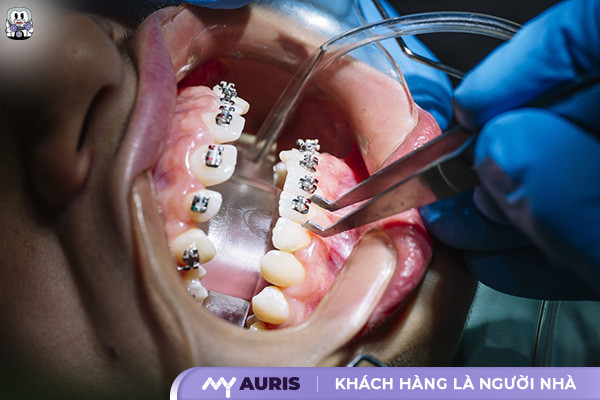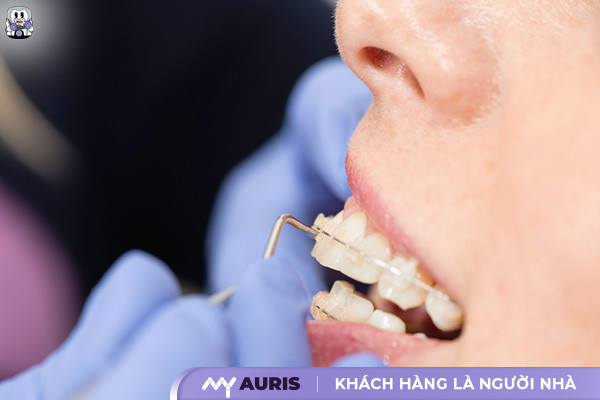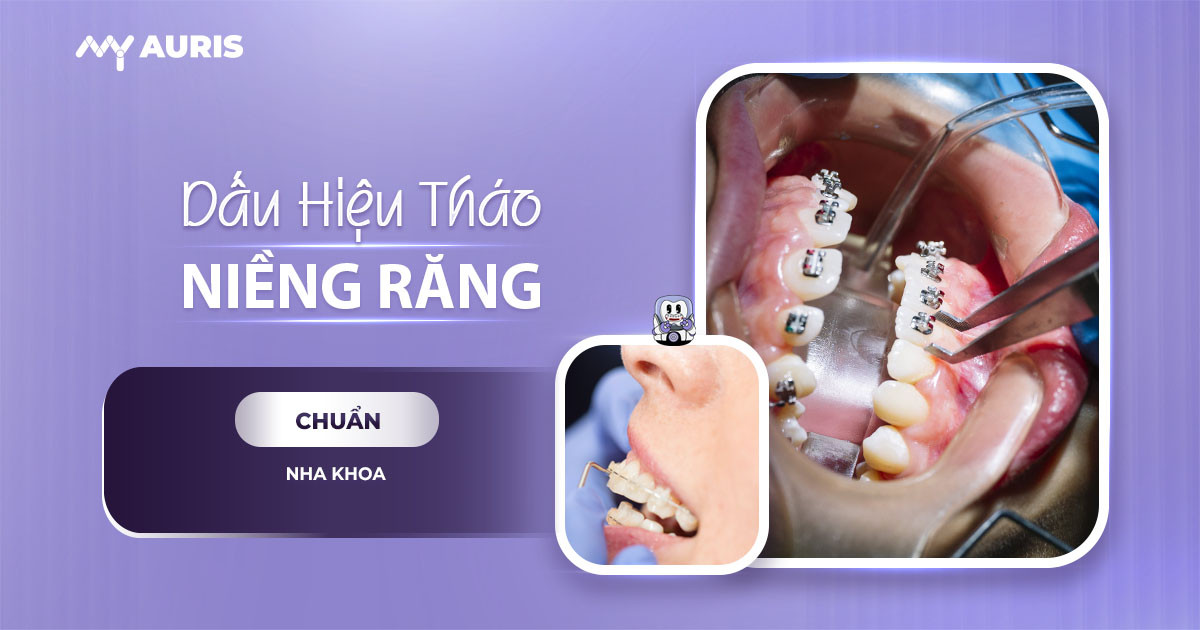Removing braces is a long-awaited step for orthodontic patients after a lengthy journey with braces or aligners. However, the timing of brace removal depends on the criteria assessed by the dentist. Removal isn’t necessarily the end; rather, it’s the beginning of a lasting orthodontic result!
6 Signs You’re Ready for Safe, Effective Braces Removal
Braces removal is a significant milestone, but it cannot be done arbitrarily. At My Auris, our team of orthodontists meticulously assesses patients based on 6 criteria for orthodontic treatment completion to ensure stable occlusion, high aesthetics, and long-term durable tooth structure.
Correct Occlusion
Correct occlusion means the upper jaw overlaps the lower jaw by about 1–2mm. Additionally, the buccal cusp of the upper first molar (tooth #6) aligns with the buccal groove of the lower first molar (tooth #6). This ensures perfect restoration of chewing function and prevents malocclusion after brace removal.
Proper Midline Alignment
The ideal midline is when the boundary between the two upper central incisors perfectly aligns with the midline of the lower jaw and the facial midline (from the forehead to the chin). In cases of congenital missing lower teeth, it is sufficient for the upper midline to align with the facial midline.
Intercuspation (Teeth interlocking)
Accurate intercuspation ensures tight contact between teeth, enhancing the stability of the entire dental arch. This is a fundamental factor for maintaining long-lasting orthodontic results.

Restored Chewing Function
After braces, chewing function must be optimal: teeth should touch evenly, and chewing forces should be evenly distributed to effectively break down food. This contributes to improved digestive health and quality of life.
Harmonious Facial Aesthetics
Upon completion of orthodontic treatment, facial aesthetics will be significantly improved: a clear profile, harmonious nose-lips-chin alignment. In cases of maxillary protrusion, the upper jaw is adjusted backward; for mandibular prognathism (underbite), the upper jaw is brought forward, recreating a correct bite and balancing the face.
Long-lasting Results
When all the above criteria are met, braces removal can be safely performed. However, for high durability, patients need to comply with periodic follow-up appointments and wear retainers as instructed by the dentist. This is an essential step to prevent teeth from shifting back to their original positions after orthodontic treatment.

How Long Does Braces Treatment Last Before Removal?
The duration of braces treatment before removal depends on various factors. For orthodontic cases that do not require tooth extraction, patients may have their braces removed after approximately 18 months if they adhere well to the treatment plan. In cases where tooth extraction is necessary to create space for tooth movement, this period can extend up to 24 months to ensure a correct bite and a harmonious smile.
If there are impacted teeth, weak jawbones, or severe misalignment, the bracing process will take longer than usual. Conversely, if braces are combined with dental veneers or crowns, the removal time may be shortened, typically ranging from a few months to 1 year depending on the specific condition.
Factors affecting the duration of braces treatment:
Age of orthodontic treatment: Adults undergoing braces typically require a longer time with the appliances because their jawbones are more stable and harder to move.
Type of braces: The choice of braces directly influences the pulling force and treatment duration. For example:
- Metal braces exert strong force, facilitating faster tooth movement and shortening orthodontic treatment time.
- Although Invisalign aligners offer high aesthetics, their treatment duration is often longer due to gentler forces.
Severity of tooth misalignment: If teeth are only slightly misaligned and the jawbone is strong, braces removal can happen quickly. Conversely, severe misalignment or weak bones will prolong the time required for wearing braces.
Oral hygiene and eating habits: Good oral care and a scientific diet help the orthodontic process proceed effectively and on schedule. Bad habits such as eating hard foods, chewing on one side, or poor hygiene can disrupt the treatment plan.
Regular check-ups: Adhering to scheduled appointments with the orthodontist helps closely monitor progress, adjust the pulling force appropriately, and ensure braces are removed at the anticipated time.

What is the Braces Removal Process at My Auris Dental Clinic?
Braces removal is the final step in the orthodontic journey, requiring precision and high skill from specialized dentists. At My Auris Dental Clinic, this process is performed thoroughly and quickly, ensuring safety for the teeth and oral cavity.
The steps for braces removal at My Auris include:
Step 1: The patient is seated in the treatment chair, positioned comfortably, and asked to open their mouth for the dentist to examine the archwire condition.
Step 2: The dentist or dental assistant gently removes the archwire from both arches.
- If you are using traditional braces, this system will be disassembled part by part.
- If you underwent Invisalign clear aligner treatment, the dentist will remove all aligners.
- If orthodontic mini-implants were used, the dentist will remove them using specialized instruments.
Step 3: After removing the mini-implants (if applicable), the oral cavity will be thoroughly disinfected with a specialized solution to eliminate bacteria and prevent infection.
Step 4: The patient is instructed to rinse their mouth, helping to clean debris and feel more comfortable after braces removal.
Step 5: To complete the process, the dentist performs scaling and polishing to remove any remaining plaque, helping the teeth become brighter, healthier, and more uniformly colored after the archwire is removed.
Braces removal at My Auris takes only about 2–3 minutes. Thanks to highly skilled professionals and modern technology, the entire procedure is quick yet still meets safety and effectiveness standards.
Important Notes After Braces Removal to Maintain a Beautiful, Lasting Smile
The first sensation after braces removal is often unfamiliar – you might feel “empty” without the brackets in your mouth. However, don’t worry, as this feeling will gradually disappear after about 2–5 days.
To stabilize tooth positions and maintain long-term orthodontic effectiveness, you need to pay attention to the following:
Clean your teeth thoroughly after every meal, especially the areas where brackets were attached, to prevent plaque buildup.
Wear your retainers correctly as instructed and for the prescribed duration, as this is a decisive factor in preventing teeth from shifting back.
Attend follow-up appointments as scheduled so the orthodontist can check stability and make adjustments if necessary.
In the initial stage, limit the consumption of chewy and hard foods such as candies, hard biscuits, or dried meat to avoid impacting the newly positioned teeth.
After braces removal, you should also consider necessary dental treatments to fully complete your smile. Depending on specific cases, such as:
- Discolored teeth due to prolonged bracing → consider teeth whitening.
- Chipped or unevenly sized teeth → consider dental fillings or porcelain veneers to improve aesthetics.
- In cases of missing teeth after orthodontic treatment to create space → dental implants are an effective restorative solution.
Each case will be thoroughly advised by the orthodontist, who will then propose the most suitable treatment plan, ensuring long-term effectiveness and a healthy, beautiful smile.





